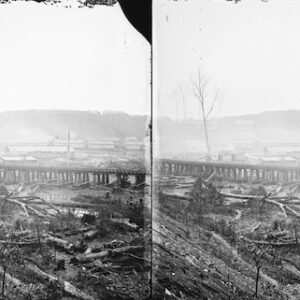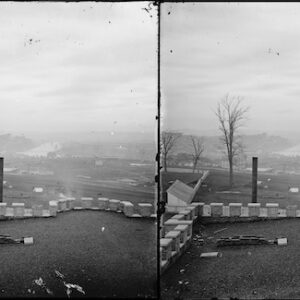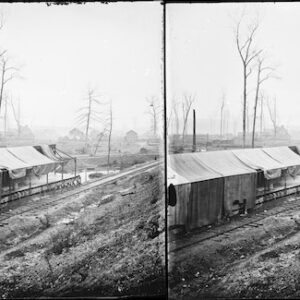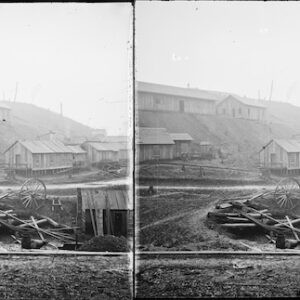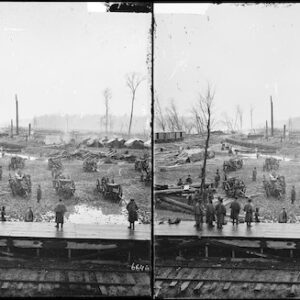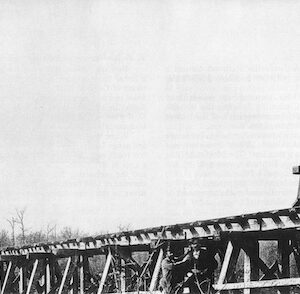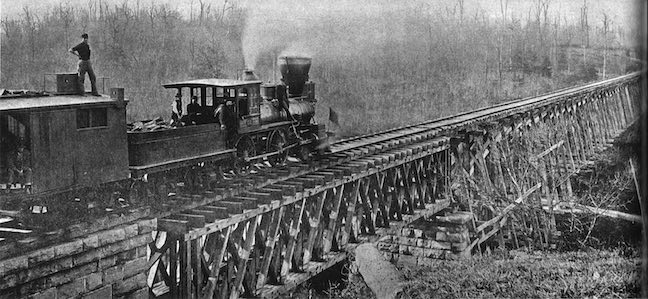Tag: Nashville & Northwestern Railroad (N&NW)
Nashville and NW RR History web site says: The Nashville & Northwestern Railroad Company was chartered by the Tennessee State Legislature on Jan. 22nd 1852. The road was to extend from Nashville, TN to Hickman, KY, a distance of 170 miles. Prior to the Civil War, a rail line ran from Nashville to Kingston Springs but no farther, which gave the line little military importance. After the federal seizure of Nashville in February 1862, work began to extend the line westward to Johnsonville on the Tennessee River, to provide another supply line for the federal armies. Free blacks as well as former slaves who sought another supply line for the federal armies. Free blacks as well as former slaves who south freedom in Union-occupied Nashville were impressed into service by federal forces to construct the Nashville-Northwestern railroad from Kingston Springs to Johnsonville. At the completion of the railroad, black laborers were inducted into official U.S. military units. The 12th and 14th U. S. Colored Troops Infantry Regiments guarded the trestles. Bridges and blockhouses along the railroad they had constructed. This 78 miles of rail became even more important after Gen. John Hunt Morgan succeeded in burning the south tunnel on the Louisville and Nashville Railroad in Sumner County. Accomplishing the task in as short a time as possible required extensive construction of wooden trestles and bridges. Because such structures were prime targets of the Confederate raiders and guerrilla parties, blockhouses and field fortifications were constructed at vulnerable bridges and trestles. The Johnsonville Depot was the western terminus of the Nashville-Northwestern Railroad. It was established at a small community called Knott’s Landing which had grown in the 1850’s along with Reynoldsburg to the north. It was renamed Johnsonville after Andrew Johnson, military governor of Tennessee, and later president of the U.S.
Throughout the summer of 1864, Gen. William T. Sherman’s federal army steadily pushed southward against the Confederate Army under Gen. Joseph Johnston, though he wasn’t able to pin down the elusive Confederates for a decisive battle. Johnston’s tactics of continuous withdrawal became increasing unpopular with Confederate President Jefferson Davis and the Southern people, so Johnston was replaced by Gen. John Bell Hood. Hood made several reckless attacks against the federals, but he was unable to check the advance. Consequently, the Confederates abandoned Atlanta to Sherman on Sept. 2, 1864. Unable to stop Sherman’s superior force, Hood decided to attack the federal rear to sever their supply line and force a withdrawal. As part of this overall plan, Gen. Nathan Bedford Forrest was sent to attack the federal depot at Johnsonville.
Leaving Corinth, Mississippi, on Oct. 16, 1864, Forrest moved northward along the Tennessee River, By the 28th he had placed artillery along the west side of the river at Paris Landing and Fort Heiman. Orders were to fire at ships headed upstream to Johnsonville since they would be loaded with supplies. They harassed federal shipping on the river for several days, capturing a gunboat and a steamer.
On Nov. 1, Forrest moved south to attack the Johnsonville Depot. On the 4th, the Confederate batteries were in place on the opposite shore at Johnsonville. Nine federal gunboats from Paducah had been sent down for support. Confederate batteries began firing at them, then at the depot itself. As the warehouses began to burn, the Federal forces panicked. Commander Col. C.R. Thompson was convinced Forrest had a superior force and would soon cross the river to capture the garrison. Though neither assumption was true, Thompson ordered the rest of the supplies destroyed to prevent their capture. Forrest pulled out the night.
During the raid, Forrest’s forces destroyed four gunboats, 14 transports, 17 barges, 33 pieces of artillery, and 75,000 to 120,000 tons of quartermaster stores. They also captured 150 prisoners and obtained much-needed supplies from captured ships. Forrest’s losses were two men killed and nine wounded. The loss of Federal property was estimated to be between $2 million and $6 million.
The loss of the depot didn’t impact the outcome of the war because Sherman had stockpiled enough supplies for this campaign in Georgia while Nashville forces relied on the reopened L&N line and the Cumberland River. Forrest had been successful, but it had come too late. After the end of the war, the railroad was turned over to President Michael Burns after the Federal government surrendered it back to it’s former owner on September 15th 1865. The railroad was later sold to the N.C. & St. Louis Railroad Company in 1873.
